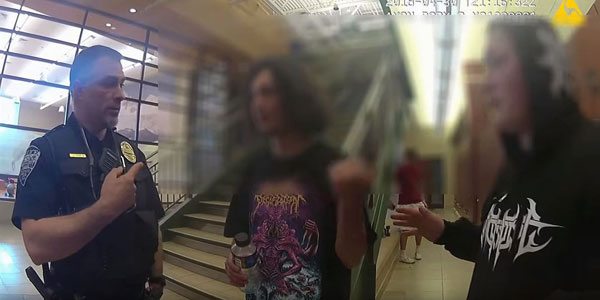
May 7, 2018; Inside Higher Ed, Washington Post, and New York Times
This month, two American Indian brothers were pulled off a college tour and confronted by campus police at Colorado State University in Fort Collins, after a concerned parent of another prospective student (identified as a white female) phoned 911 to report them as suspicious while on the tour. The incident was captured on a campus security personnel body camera and widely viewed on various internet channels.
The event at Colorado State follows closely on the heels of another well-publicized incident in which a Starbucks employee called on the police to arrest two Black customers, Rashon Nelson and Donte Robinson, who were calmly seated at a table. In both cases, there is an overt act of racism, but there is also a background condition of people of color being not so subtly pressured to “fit in” to spaces, that, as NPQ’s Cyndi Suarez, quoting Jamelle Bouie in Slate, put it, are “putatively diverse, but curated for the experiences of white people.”
The unfortunate event prompted the university’s president, Tony Frank, to issue a terse statement about the values of Colorado State and to acknowledge that “two young men, through no fault of their own, wound up frightened and humiliated because another campus visitor was concerned about their clothes and overall demeanor, which appears to have simply been shyness.” He goes on to add that if you don’t appreciate diversity, CSU is not the home for you.
The very idea that someone—anyone—might ‘look’ like they don’t belong on a CSU admissions tour is anathema. People of all races, gender identities, orientations, cultures, religions, heritages, and appearances belong here. As long as you want to earn a great education surrounded by people with the same goal who come from every part of our state, our country, and our world, then you belong here. And if you’re uncomfortable with a diverse and inclusive academic environment, then you probably have a better fit elsewhere.
Sign up for our free newsletters
Subscribe to NPQ's newsletters to have our top stories delivered directly to your inbox.
By signing up, you agree to our privacy policy and terms of use, and to receive messages from NPQ and our partners.
This problem with people of color being suspect and at-risk in this country’s public spaces has existed for centuries, but now it’s more often called out on social media and documented by the press. As institutions responsible for helping to educate an ever more diverse population, it is insufficient for a university or college to see the problem as embodied in one parent who calls the problem in to the institution’s security force.
CSU is, of course, a state school, but nonprofit colleges capture a significant percentage of the highly competitive student enrollment market, and this requires them to interrogate their own cultures more closely. “These institutions enroll a substantial share of students at four-year colleges: 3.4 million full-time equivalent students, or 30 percent of all four-year enrollment (compared to 61 percent at public colleges and nine percent at for-profits).” And despite myths that private colleges and universities trend historically white, “for private colleges, enrollment growth among historically underrepresented racial and ethnic groups has outpaced total enrollment growth over the past decade,” according to the National Association of Independent Colleges and Universities.
As employers, colleges and universities must work hard to ensure a welcoming culture. According to the recently released Johns Hopkins report, 2018 Nonprofits: America’s Third Largest Workforce, nonprofits nationally make up 11.9 percent of the workforce, trailing only the industries of manufacturing and retail. Higher education alone makes up nearly 16 percent of nonprofit employment in the US. And while nonprofit educational institutions are less than one percent of the overall nonprofit sector, they hold almost 20 percent of all charitable assets in this country. Further, this group of nonprofits has seen a 42 percent increase in revenue over the ten-year period between 2003 and 2013.
All of this is to say that this segment of the nonprofit universe, in whose hands are held our country’s future leaders and citizens, has a tremendous responsibility to create environments where no young person faces this kind of treatment. Of course, we all know that institutions are made up of mere individuals, and this is where we have to start—with each and every one of us. CSU President Frank was right to raise these questions.
“What can we learn from it to make ourselves and our community more just?” Frank asked. “It seems to me that we can all examine our conscience about the times in our own lives when we’ve crossed the street, avoided eye contact, or walked a little faster because we were concerned about the appearance of someone we didn’t know but who was different from us. That difference often, sadly, includes race. We have to be alert to this, look for it, recognize it—and stop it. We simply have got to expect and to be better; our children and our world deserve it and demand it.”
—Jeannie Fox












